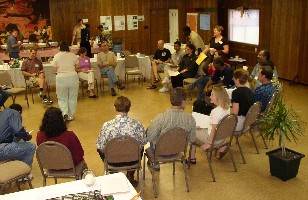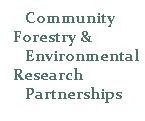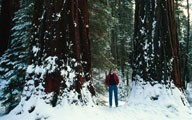|
2000 - 4th Annual CFERP Workshop -
New Mexico
The CFERP Program held its fourth annual workshop from October 4 to 8, 2000 , at the Ghost Ranch Conference Center in Abiquíu , New Mexico. Forty people attended the workshop including fellows, academic advisors, community representatives, steering committee members, and several invited guests.
The workshop included an interactive session on community forestry, presentations by the fellows and their community partners, a panel discussion with local community forestry practitioners, a field trip to Truchas, New Mexico, and a training session on participatory methods conducted by Dr. Jacqueline Ashby of the International Center for Tropical Agriculture (CIAT).
The workshop opened with steering committee member Professor John Bliss facilitating a session exploring the major themes in community forestry in the United States. Workshop participants wrote down their ideas concerning the principles, values, and themes of community forestry as well as its opportunities and challenges on index cards and then orally presented these to the entire group. A post-workshop analysis of the ideas presented revealed three major underlying themes:
1) a central goal of community forestry efforts is preserving local ways of life,
2) communities need access to resources to maintain a particular way of life,
3) communities need meaningful participation in decisions affecting the magnitude and direction of economic, social and cultural change.
It is notable that there were relatively few comments dealing specifically with the environment. Evidently the concerns of the CFERP workshop participants were focused on social, economic and political issues.

The three themes were evident throughout the workshop. For example in his presentation on minority issues in community forestry Rodney Stone, Forest Service Liaison at Southern University, noted that there are proportionally fewer minorities in the natural resource professions, that oftentimes there is only token minority representation on advisory boards and that this creates an “illusion of inclusion,” and that agendas for natural resource management do not necessarily include the needs and aspirations of minority communities.
The three themes were evident in the presentations the fellows made as well. All of the presentations dealt with conflict over resource management in local situations to a greater or lesser extent. The extent to which conflict was a theme in the presentations is evident in the number of presentation titles with the word “conflict” in them. At the core of the conflicts in the case studies were questions of access and participation. In addition, the theme of preserving ways of life ran through many of the presentations and was a central issue in some. For example, the presentation by Jonathan Long (fellow) and Mae Burnett (community partner) on “Design of Restoration Treatments for Riparian Wetlands on the White Mountain Apache Reservation” highlighted the links between riparian restoration and maintenance of traditional cultural values on the White Mountain reservation. Alexandre Mas’ presentation on “Enriching Ecosystem Management in the Northern Forest through Participatory Research with Maple Syrup Producers” illustrated a different, but related, process of maple sugaring being valued more as an integral part of a way of life than as an income-earning economic activity.
In addition to the three broad themes identified, more detailed concerns became apparent during the workshop as well. For example, three main points emerged from a panel discussion with small loggers operating in northern New Mexico: 1) small loggers need technical assistance with all aspects of marketing; 2) they need technical assistance in increasing the value of their products (i.e. producing grade lumber) as well as in maintaining consistent quality in their production; and 3) they need assistance in adjusting to working with small diameter logs.
On Saturday the entire group went on a field trip to Truchas, New Mexico, to view firsthand the thinning work that La Montaña de Truchas, a community-based organization headed by Max Cordova, has been doing on national forest lands. While touring two sites on the national forest, Mr. Cordova addressed the group, explaining the work his organization is doing and how it is helping his community as well as the forest. He pointed out that the thinning work has resulted in increases in wildlife on the lands involved. He also suggested that one value of local community involvement in national forest management is that local community members are providing stewardship services on public lands for the rest of the nation. In his words, “we’re taking care of the land for you.”
After the tour, the group returned to La Montaña’s headquarters for a lunch of traditional New Mexican food. After lunch, several speakers addressed the group. Community activist Santiago Juarez began with a moving presentation about the legacy that speculation in land grants in the late nineteenth century has left for contemporary northern New Mexico communities. This legacy includes a diminished land base, degraded land in many areas, and a keen sense that their lands were stolen among members of many Hispano and Native American communities. Other speakers talked about rural economic development in northern New Mexico, and one spoke about the alienation from the natural world she sees among residents of urban areas.
Perhaps the most memorable talk was that given by local community activists Kay Matthews and Mark Schiller who discussed problems in foundation-funded projects in northern New Mexico. They argued that foundations in general, and the Ford Foundation in particular, frequently fund projects in the region that work at cross purposes to one another. They asserted that many environmental groups whose campaigns often result in actions that prevent local communities from engaging in their traditional livelihood activities are funded by the same foundations that fund community development programs in those same communities. They also argued that often there is a lack of transfer of technical expertise to people in local communities so that funded programs do not build local capacity for managing ongoing projects or for developing and implementing future projects. This presentation stirred some lively discussion and certainly gave the CFERP workshop participants a taste of the politics surrounding land use and resource management issues in northern New Mexico.
On the last morning of the workshop Dr. Jacqueline Ashby of CIAT, an expert in participatory research methods, conducted a training session in participatory action research (PAR). Dr. Ashby outlined the basic principles of PAR and explained the use of three specific field methods: stakeholder analysis, matrix ranking, and forcefield analysis. The session helped to ground many of the methodological issues that had arisen in earlier workshop presentations in concrete concepts and techniques. This was important not only for addressing questions fellows had about their own research, but also for advancing understanding among other workshop participants of the role participatory research plays in advancing community forestry efforts.
The workshop concluded with a special brainstorming session on recruiting under-served students into the CFERP program.
The 2000 CFERP workshop thus accomplished many things. First, it identified common themes across the many case studies presented, and provided illustrations of how these common themes play out through interaction with unique historical and socio-cultural factors in specific local settings. The field trip to Truchas, for example, demonstrated how history shapes contemporary land use and resource management conflict. It also raised difficult questions about possible unintended consequences of foundation funding in local communities.
Second, through the training session on PAR, the workshop advanced the goals of the CFERP program in the area of promoting wider acceptance of participatory research methods in academia.
Third, through the participation of the specially invited guests as “resource people”, the workshop succeeded in expanding networks and in creating additional institutional connections for itself as well as for the fellows and their community partners. One outcome of the networks created during the 2000 workshop was the development of an ongoing working relationship with Eva Harris, a small forest owner from Canyon City, Oregon, who attended the workshop as M.A. Fellow Stefan Bergmann’s community partner. As a result of this working relationship Eva was funded to attend two separate events. One was an interagency (BLM and Forest Service) sponsored workshop which trained participants to meet the requirements of the Endangered Species and Clean Water acts in ways intended to avert conflict and gridlock when implementing ecosystem restoration projects in their communities. Eva was also funded to attend the Rural Sociological Society’s annual meetings in August, 2001, to participate in the panel discussion on community forestry which the program coordinator organized (see below).
Fourth, inviting special guests also had an important impact on the recruitment of fellows. Not only did the guests contribute to the brainstorming session on minority recruitment, but two of them, Ronald Trosper and Rodney Stone, encouraged some minority students to apply for a fellowship during the 2001 competition. Two of these students were ultimately accepted into the program.
Finally, one measure of the success of the workshops is having people, such as Marshall Murphree of the University of Zimbabwe, request to attend the 2001 workshop.
|







